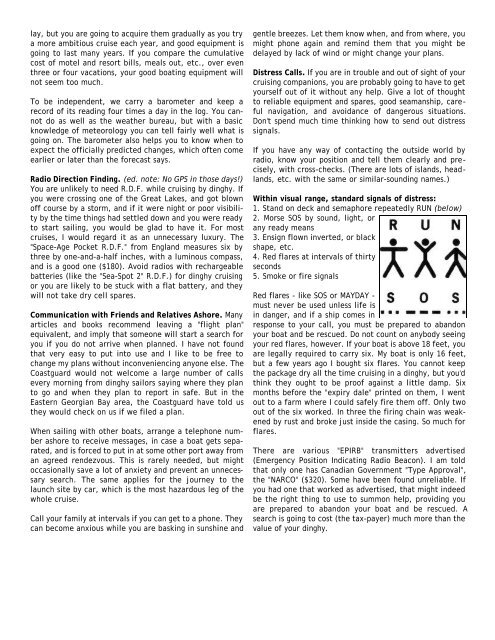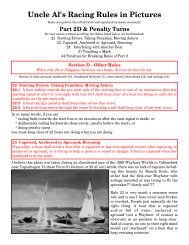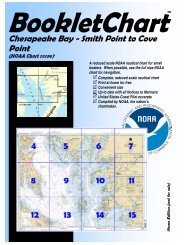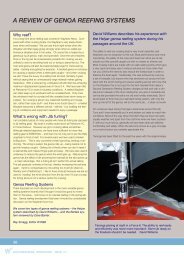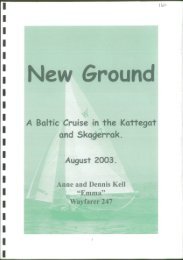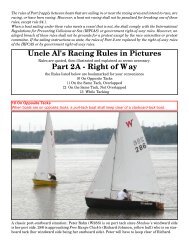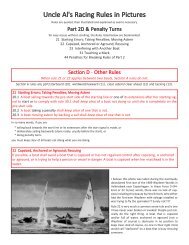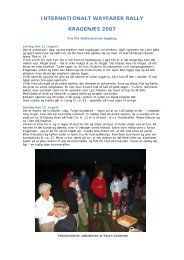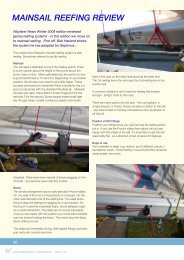Contents - Wayfarer Institute of Technology
Contents - Wayfarer Institute of Technology
Contents - Wayfarer Institute of Technology
You also want an ePaper? Increase the reach of your titles
YUMPU automatically turns print PDFs into web optimized ePapers that Google loves.
lay, but you are going to acquire them gradually as you try<br />
a more ambitious cruise each year, and good equipment is<br />
going to last many years. If you compare the cumulative<br />
cost <strong>of</strong> motel and resort bills, meals out, etc., over even<br />
three or four vacations, your good boating equipment will<br />
not seem too much.<br />
To be independent, we carry a barometer and keep a<br />
record <strong>of</strong> its reading four times a day in the log. You cannot<br />
do as well as the weather bureau, but with a basic<br />
knowledge <strong>of</strong> meteorology you can tell fairly well what is<br />
going on. The barometer also helps you to know when to<br />
expect the <strong>of</strong>ficially predicted changes, which <strong>of</strong>ten come<br />
earlier or later than the forecast says.<br />
Radio Direction Finding. (ed. note: No GPS in those days!)<br />
You are unlikely to need R.D.F. while cruising by dinghy. If<br />
you were crossing one <strong>of</strong> the Great Lakes, and got blown<br />
<strong>of</strong>f course by a storm, and if it were night or poor visibility<br />
by the time things had settled down and you were ready<br />
to start sailing, you would be glad to have it. For most<br />
cruises, I would regard it as an unnecessary luxury. The<br />
"Space-Age Pocket R.D.F." from England measures six by<br />
three by one-and-a-half inches, with a luminous compass,<br />
and is a good one ($180). Avoid radios with rechargeable<br />
batteries (like the "Sea-Spot 2" R.D.F.) for dinghy cruising<br />
or you are likely to be stuck with a flat battery, and they<br />
will not take dry cell spares.<br />
Communication with Friends and Relatives Ashore. Many<br />
articles and books recommend leaving a "flight plan"<br />
equivalent, and imply that someone will start a search for<br />
you if you do not arrive when planned. I have not found<br />
that very easy to put into use and I like to be free to<br />
change my plans without inconveniencing anyone else. The<br />
Coastguard would not welcome a large number <strong>of</strong> calls<br />
every morning from dinghy sailors saying where they plan<br />
to go and when they plan to report in safe. But in the<br />
Eastern Georgian Bay area, the Coastguard have told us<br />
they would check on us if we filed a plan.<br />
When sailing with other boats, arrange a telephone number<br />
ashore to receive messages, in case a boat gets separated,<br />
and is forced to put in at some other port away from<br />
an agreed rendezvous. This is rarely needed, but might<br />
occasionally save a lot <strong>of</strong> anxiety and prevent an unnecessary<br />
search. The same applies for the journey to the<br />
launch site by car, which is the most hazardous leg <strong>of</strong> the<br />
whole cruise.<br />
Call your family at intervals if you can get to a phone. They<br />
can become anxious while you are basking in sunshine and<br />
gentle breezes. Let them know when, and from where, you<br />
might phone again and remind them that you might be<br />
delayed by lack <strong>of</strong> wind or might change your plans.<br />
Distress Calls. If you are in trouble and out <strong>of</strong> sight <strong>of</strong> your<br />
cruising companions, you are probably going to have to get<br />
yourself out <strong>of</strong> it without any help. Give a lot <strong>of</strong> thought<br />
to reliable equipment and spares, good seamanship, careful<br />
navigation, and avoidance <strong>of</strong> dangerous situations.<br />
Don't spend much time thinking how to send out distress<br />
signals.<br />
If you have any way <strong>of</strong> contacting the outside world by<br />
radio, know your position and tell them clearly and precisely,<br />
with cross-checks. (There are lots <strong>of</strong> islands, headlands,<br />
etc. with the same or similar-sounding names.)<br />
Within visual range, standard signals <strong>of</strong> distress:<br />
1. Stand on deck and semaphore repeatedly RUN (below)<br />
2. Morse SOS by sound, light, or<br />
any ready means<br />
3. Ensign flown inverted, or black<br />
shape, etc.<br />
4. Red flares at intervals <strong>of</strong> thirty<br />
seconds<br />
5. Smoke or fire signals<br />
Red flares - like SOS or MAYDAY -<br />
must never be used unless life is<br />
in danger, and if a ship comes in<br />
response to your call, you must be prepared to abandon<br />
your boat and be rescued. Do not count on anybody seeing<br />
your red flares, however. If your boat is above 18 feet, you<br />
are legally required to carry six. My boat is only 16 feet,<br />
but a few years ago I bought six flares. You cannot keep<br />
the package dry all the time cruising in a dinghy, but you'd<br />
think they ought to be pro<strong>of</strong> against a little damp. Six<br />
months before the "expiry dale" printed on them, I went<br />
out to a farm where I could safely fire them <strong>of</strong>f. Only two<br />
out <strong>of</strong> the six worked. In three the firing chain was weakened<br />
by rust and broke just inside the casing. So much for<br />
flares.<br />
There are various "EPIRB" transmitters advertised<br />
(Emergency Position Indicating Radio Beacon). I am told<br />
that only one has Canadian Government "Type Approval",<br />
the "NARCO" ($320). Some have been found unreliable. If<br />
you had one that worked as advertised, that might indeed<br />
be the right thing to use to summon help, providing you<br />
are prepared to abandon your boat and be rescued. A<br />
search is going to cost (the tax-payer) much more than the<br />
value <strong>of</strong> your dinghy.


